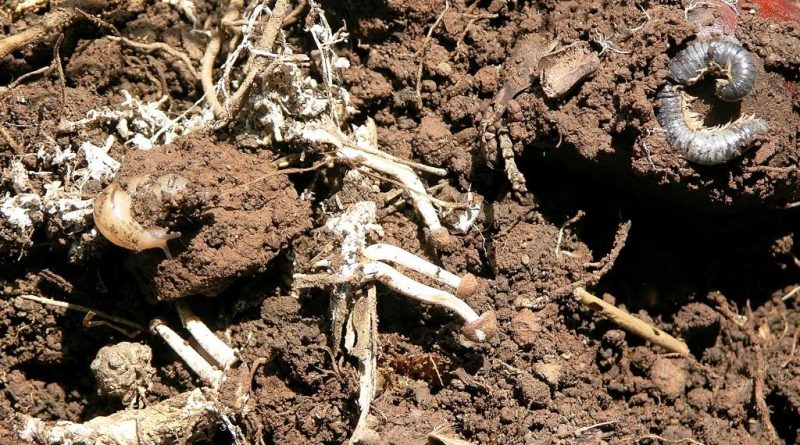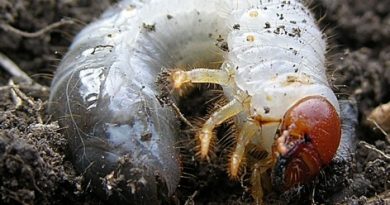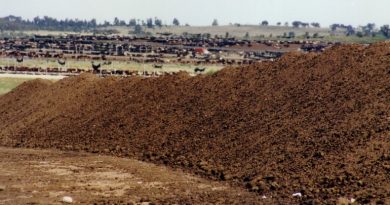Fertilise the system to build soil organic matter – SOM is more than carbon
By John Kirkegaard
In 2007, Clive Kirkby was a soil scientist with CSIRO working on ways to deal with heavy crop stubbles when he proposed a hypothesis that was to become the basis of his PhD studies. Clive was frustrated that in a long-term tillage trial at Harden soil carbon levels had changed very little despite 20 years of stubble retention.
Clive knew that soil organic matter (SOM) is not just carbon. It contains nitrogen, phosphorus and sulfur in predictable ratios that reflect the ratios found in the soil microbes.
This is because up to 70 per cent of stable SOM is made up of dead microbes. Microbes require nutrients (nitrogen, phosphorus and sulfur) as well as energy (carbon) to grow their populations in soil, and then die to create new SOM. It was expected that SOM would provide fertility, but it had been forgotten that fertility was needed to build it.
Clive hypothesised that a lack of nutrients, not just a lack of carbon, could be limiting SOM formation when retaining stubble at Harden. Nutrients were only applied when the crop needed them, and the focus on ‘nutrient use efficiency’ was leaving the microbes short.
He showed that irrespective of the soil type or amount of carbon in the soil, each tonne per hectare of soil carbon that is sequestered in SOM required 85 kilograms of nitrogen, 20kg of phosphorus and 14kg of sulfur. If those nutrients were not available in the soil when heavy carbon-rich stubble was retained, the microbes could not grow. In fact, they would break down existing organic matter to get the nutrients they need, with a loss of carbon dioxide.
This loss of existing SOM offset much of the benefit that the new carbon added. Finally, it appeared Clive had an answer to why long-term stubble retention in some cases had not increased SOM as expected.
To test the hypothesis in the laboratory, experiments were conducted with stubble added to moist soil with and without nutrients. Figure 1A shows that in the absence of nutrients, the microbes could not utilise the carbon in the residue to grow their populations and the chopped stubble remained largely intact. In contrast, Figure 1B shows that when nutrients were added in the correct ratios, the microbes grew rapidly, used all of the stubble and their residues and exudates (new SOM) generated a very different soil. On four contrasting soils, carbon sequestration was increased two to four-fold with the addition of the supplementary nutrients.
Figure 1: The effect of added nutrients on the conversion of wheat stubble to new soil organic matter on a sandy soil: a) no nutrients added, and b) nutrients added, in correct ratios. Source: CSIRO
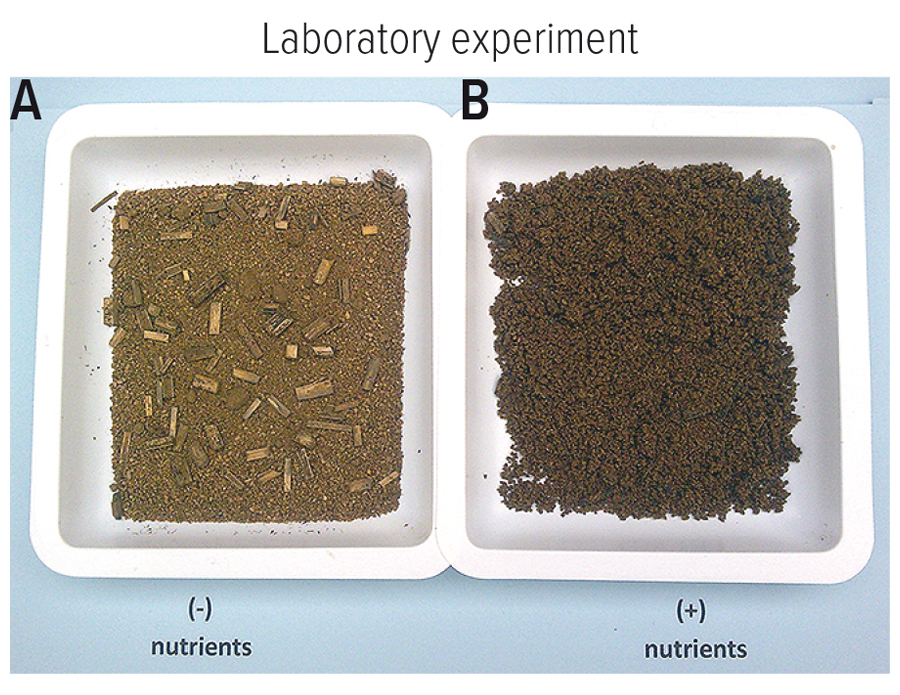
Proof of concept in the field
The CSIRO team went on to prove the concept in the field at Harden. Crop residue (9 t/ha cereal or canola stubble) was incorporated on the first rain after harvest using a rotary hoe with and without supplementary nutrients every year for five years (Figure 2). The nutrients were applied to achieve ratios favoured by the microbes (equivalent to around 5kg of nitrogen, 1.5kg of phosphorous and 1kg of sulfur per tonne of wheat stubble).
After five years, the treatment without nutrients had lost 3.3t/ha of carbon while the treatment with supplementary nutrients gained 5.5t/ha of carbon – a difference of 8.8t/ha of carbon over five years despite both receiving the same amount of residue. This was the first treatment to reverse the loss of SOM at the site under continuous cropping.
The CSIRO team continued adding nutrients for a further three years during which the soil carbon increased further to around 10t/ha. They then ceased the nutrient addition but kept the stubble incorporation going for a further five years. During this period the extra SOM that had been sequestered began to diminish, with the difference reducing to 3t/ha. This demonstrated that adequate nutrient supply must be maintained in the system to avoid ongoing mining of the SOM.
Figure 2: The effect of supplementary nutrients applied to incorporated crop residues at Harden over five years. Granular fertiliser was sprinkled onto the stubble before incorporation. Source: CSIRO
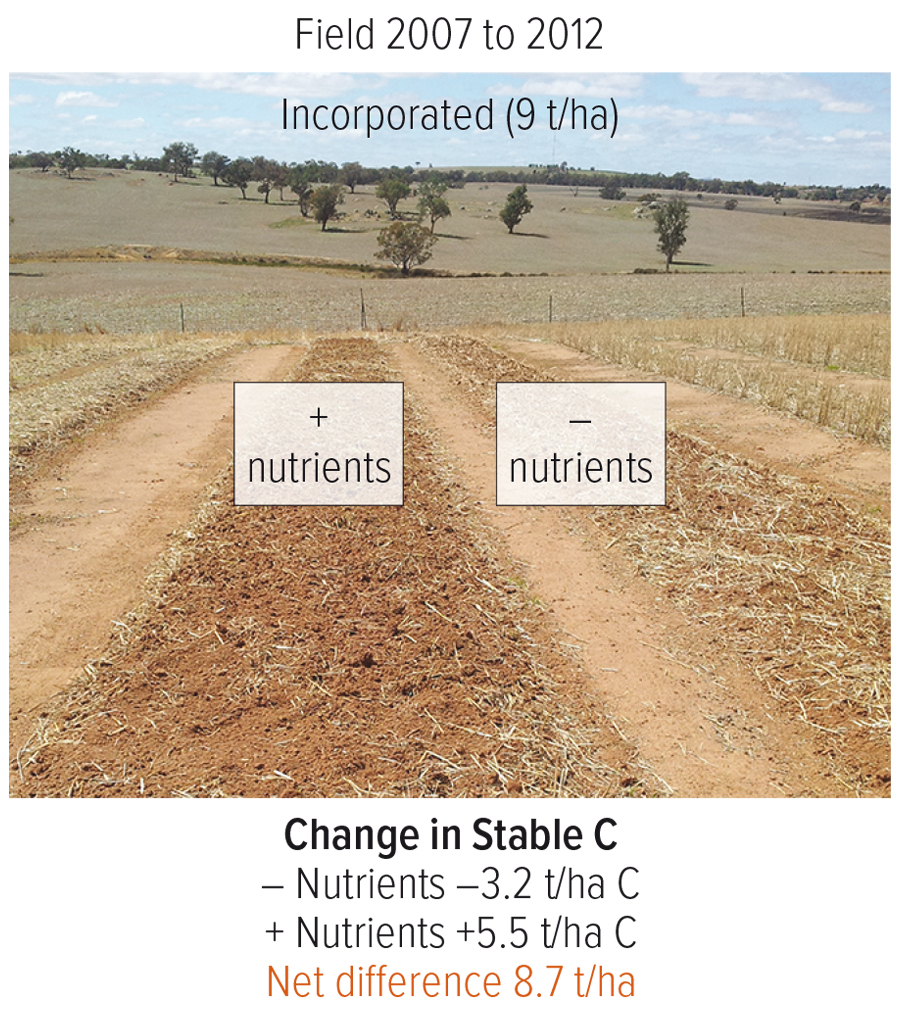
Economics
A simple economic analysis compared the cost of the additional fertiliser against the change in income from increased yield and potential payments for sequestered carbon (at $40/t carbon dioxide equivalents).
Using average costs, a profit of $1586 from an investment of $1109 (return on investment of 1.43) was achieved over eight years.
The best-case scenario (high grain and carbon prices, low fertiliser prices) generated a potential profit of $2722 (return on investment of 2.45), while only the worst-case scenario (low grain and carbon prices, high fertiliser prices) generated a small loss ($240/ha over eight years).
Overall, while nutrient addition was maintained, the likelihood of economic loss was low. However, after five years without nutrient addition, the likelihood of generating a loss increased because the extra SOM had diminished and reduced the income from carbon sequestration. This reinforces the fact that the SOM created can be lost if the system returns to a negative nutrient balance for a long period.
New questions – new project
A farming system in which inadequate nutrients limit crop productivity, microbial activity and maintenance of SOM clearly requires a paradigm shift.
And the shift is not to simply add more or less fertiliser, as different farming philosophies advocate. The new paradigm must focus on the balance and timing of nutrient supply with a focus on the system, not just the crop.
Our hypothesis is that novel nutrient supply strategies based on the stoichiometric ratios of the microbial biomass can rebuild SOM and soil health in productive, profitable farming systems.
(Followup question: Can you give an example of such stoichiometric ratios of microbial biomass so it can be related to my question three paragraphs below?)
Such a paradigm shift to ‘fertilise the system, not just the crop’ must operate within the economic and risk framework of real farms, a fact firmly embedded in the research approach.

Figure 3: The new paradigm must focus on the balance and timing of nutrient supply with a focus on the system, not just the crop. Photo: Spreading chicken manure, Patrick Francis.
Based on the underpinning theory, we hypothesise numerous avenues to reduce cost and increase effectiveness of the strategy on different soils by manipulating:
- the nutrient forms (liquid, granular, mixtures, formulations);
- timing and rates;
- positioning (on stubble, broadcast, in-furrow); and
- tailoring the nitrogen, phosphorous and sulfur applied to existing nutrients in soil and residue.
No commercial fertilisers currently target nitrogen, phosphorous and sulfur ratios to build SOM from residue, meaning that fertiliser companies could innovate in product development.
(Followup question: Could you provide an example(s) of N:P:S ratio targets that build SOM from stubble residue? What ratios are positive to build SOM?)
A new, collaborative GRDC investment involving CSIRO, Kalyx Australia and Delta Agribusiness commenced in 2023. It will establish and test 10 different nutrient supply strategies in fully replicated on-farm field experiments at eight sites representing key soil types and climatic diversity across Australia’s grain belt.

Figure 4: Treatments imposed as part of the new project at Monteagle: standing stubble (left), rotary hoe (centre), and speed tiller (right). All these treatments are being tested with and without foliar and granular nutrients. Photo: CSIRO
The project will focus on medium to high-rainfall sites where nutrient supply (rather than stubble quantity) may limit carbon sequestration. The sites will also test some approaches in commercial strips and build local networks to ensure technical feasibility and acceptable economic risk at farm scale.
Different N:P:S ratio fertiliser treatments will be reapplied annually to stubble after harvest in randomised field plots with four replicates over a five-year period (2022 to 2026 stubbles) to measure effects on soil carbon sequestration, soil health and biological activity, crop productivity and profitability.
Understanding the nutrient requirement of the soil microbial biomass (from which up to 70 per cent of the stable SOM is derived) must be lifted to the same level as the nutrient requirements of crops and communicated as effectively if we are to maintain both food productivity and soil fertility.
(Followup question: Will be interesting to read what the differences are between nutrient requirements of soil microbial biomass and requirements of crops – do you have any thoughts at this stage?)
These are issues that have been largely overlooked in the debate about sequestering carbon in soil. The knowledge generated in this project regarding the underpinning impact of nutrients on microbial and SOM dynamics will be vital to develop the most effective and economic strategies to restore Australian soils.
Find out more:
John Kirkegaard is a CSIRO soil scientist, john.kirkegaard@csiro.au
This article is sourced from GRDC Ground Cover June 2023 or visit Fertilising the system, not just the crop, can build soil organic matter | Groundcover (grdc.com.au)

